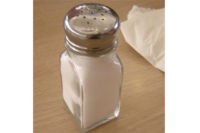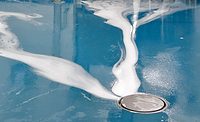A consistent, plentiful, sustainable and safe water supply is crucial for all players in the food and beverage industry. But monitoring a water system and getting clean samples aren’t easy, if your site is a victim of poor design, contamination or the wrong materials. Jason Mitchell, project manager at US Water Services, Inc., discusses these issues with Food Engineering and how to avoid pitfalls when it comes to piping systems.
FE: What is high-purity water, and where is it used?
Jason Mitchell: High-purity water, also referred to as ultrapure or deionized water, complies with quality requirements to sustain specific production goals and standards. It is used in a variety of industries where bacterial contamination is strictly regulated such as biopharmaceutical, electronics manufacturers, hospitals, laboratories and power generation [solar].
FE: Are there different types of high-purity water?
Mitchell: Yes, specification levels are based on the requirements from governing bodies and include pharmaceutical-, semi-conductor- and reagent-grade water systems. Product water such as water for injection [WFI], or an ingredient in drug product production, carries United States Pharmacopeia [USP] designation. Water used in food is typically regulated by FDA and must utilize “food-grade” equipment and instruments, while reagent water for analytical purposes is subject to American Society for Testing and Materials [ASTM] standards. Once the system requirements and specifications have been defined, the treatment or piping system can be designed.
FE: How does bacterial growth affect high-purity water systems?
Mitchell: Water provides an ideal environment for bacterial development. Nutrients that bacteria eat can form on the hard surfaces of a water piping system, and defects in piping, connection points, welds or fittings can contribute to bacterial contamination.
FE: Why is piping design important in high-purity water systems?
Mitchell: Identifying and treating potential bacterial formation problems once a system is in operation can be much more difficult than addressing them during the system design. Issues with bacterial growth on systems during operation are corrected by replacing or rerouting piping and heat tracing. These corrective actions are not preferred as a final solution due to the ongoing expense associated with them.
FE: What should be considered when designing system piping?
Mitchell: To prevent the growth of bacteria, the system engineer must consider nutrient sources, contamination sites, colony forming zones [CFZs], piping materials and the location of corrective facilities.
Nutrient sources are locations where the food required for bacteria to flourish may be introduced. CFZs are areas where, given the proper environment and nutrient availability, bacteria grow and multiply. The most common CFZs are “dead legs” or areas of low to no flow, greater than six diameters.
Contamination sites are locations in the system where nutrients enter the process loop. Minimizing or eliminating fitting connections that allow air bleed within a piping layout is important. Certain piping materials, such as some plastic piping materials, can also allow oxygen to enter the system via absorption through the pipe wall. The installation of corrective facilities in piping systems allows access to the system for sanitization through the introduction of steam, ozonation, chlorinators, storage at elevated temperatures, etc.
FE: How do you prevent creating contamination sites throughout the piping system?
Mitchell: Focusing on a piping layout that minimizes connections or fittings is important, getting as near a fully closed loop as possible. The most common fitting type in a high-purity system is a sanitary fitting (commonly called at tri-clamp) connection. Threaded and even flanged connecting is viewed as less proper.
FE: How does the selection of piping material affect contamination?
Mitchell: While oxygen permeability of piping is not a huge consideration when using stainless steel piping or tubing, it is an important aspect of dealing with poly piping. Typically, high-purity systems incorporate the use of low-extractable [LXT] or high-density polyethylene piping [HDPE] due to lower cost and ease of maintenance. LXT piping prevents the leaching of extractable constituents such as chlorides and TOC from the piping into the process water. However, while both LXT and HDPE offer some standard type fittings, it is typically not possible to get tri-clamp connections, which limits the sanitary design potential.
The best practice is to use high-polished stainless steel fora purity system’s process lines. As a part of quality control, all welds should be tested and examined. It is also good practice to conduct regular cleaning or sanitation of any system with low bacteria level requirements.
FE: What is the sanitization process once a system has been installed?
Mitchell: Water systems contain bacteria, so regular sanitization, based on required testing and historical data, is necessary to prevent the prolonged growth of bacteria. . Sanitization requires the system to be taken out of service and flushed when complete, prior to returning it to service. The most preferred and most common methods of sanitization include steam or ozonation. In some instances, plants may choose sodium hypochlorite or bleach for sanitization. However, overtime, bleach can be corrosive to stainless steel piping. Also, by using bleach, you are introducing a contaminant into the system. Lastly, many systems must adhere to a chloride limit. These systems are required to monitor chlorine levels and may need to be flushed for a prolonged amount of time before being returned to service.
FE: What are the common monitoring and sampling processes once a system has been installed?
Mitchell: It is important to follow an approved monitoring and sampling plan. Point use of sampling, or sampling after the treatment component, is critical in identifying the locations of bacterial growth and contamination. The further upstream in a process that you can apply the performance qualification, the more likely you are to catch issues that may cause a system to fall away from expectations.
The method of testing can vary depending on the measured constituent and to what specification the system must adhere. ASTM standards outline the acceptable testing methods for water constituents and water treatment equipment. When monitoring, the use of proper instrumentation should be taken into account to give plants the ability to alert operations of significant changes from normal operating conditions. The limits of an alert should be defined and acceptable in accordance with the system requirements.





